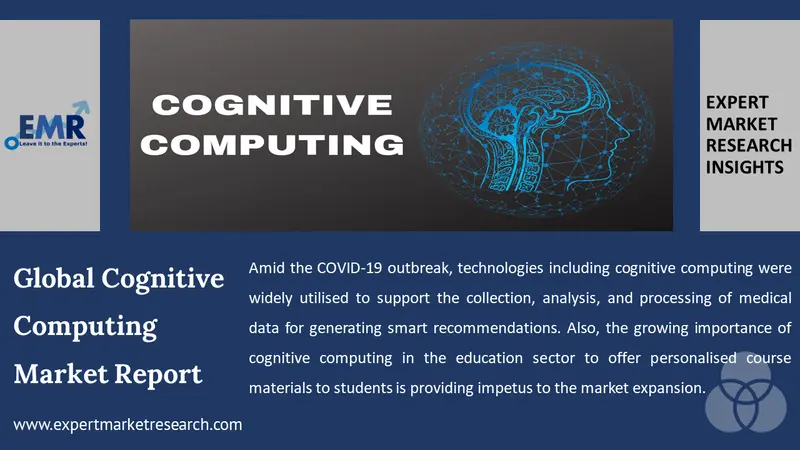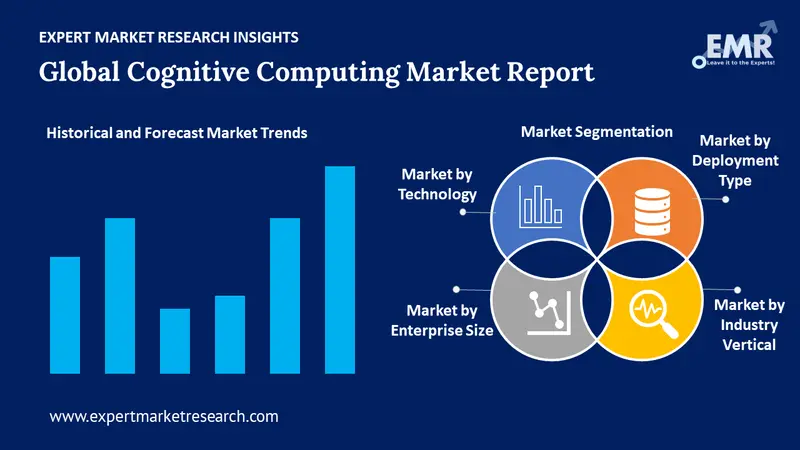
Consumer Insights
Uncover trends and behaviors shaping consumer choices today
Procurement Insights
Optimize your sourcing strategy with key market data
Industry Stats
Stay ahead with the latest trends and market analysis.
The global cognitive computing market attained a value of approximately USD 49.17 Billion in 2025. The market is further expected to grow in the forecast period of 2026-2035 at a CAGR of 25.60%, reaching a value of around USD 480.39 Billion by 2035.
Base Year
Historical Period
Forecast Period
Compound Annual Growth Rate
25.6%
Value in USD Billion
2026-2035
*this image is indicative*
| Global Cognitive Computing Market Report Summary | Description | Value |
| Base Year | USD Billion | 2025 |
| Historical Period | USD Billion | 2019-2025 |
| Forecast Period | USD Billion | 2026-2035 |
| Market Size 2025 | USD Billion | 49.17 |
| Market Size 2035 | USD Billion | 480.39 |
| CAGR 2019-2025 | Percentage | XX% |
| CAGR 2026-2035 | Percentage | 25.60% |
| CAGR 2026-2035 - Market by Region | North America | 28.8% |
| CAGR 2026-2035 - Market by Country | USA | 28.5% |
| CAGR 2026-2035 - Market by Country | China | 26.3% |
| CAGR 2026-2035 - Market by Deployment Type | On-Premise | 28.7% |
| CAGR 2026-2035 - Market by Industry Vertical | Energy and Power | 29.2% |
| Market Share by Country 2025 | Italy | 2.8% |
As the efficiency and accuracy of cognitive computing continue to rise, the market is expected to witness substantial growth and increasing applications, particularly across crucial industries. With expansion of healthcare infrastructure and rapidly rising number of patients, cognitive computing is increasingly being utilised in the healthcare sector, supported by increasing penetration of machine learning and artificial intelligence (AI). Advancements in the broader cognitive computing market are aiding the seamless integration of cognitive computing with public dealing in multiple fields.
Over the forecast period, the anticipated increase in healthcare expenditure of emerging economies and incorporation of advanced medtech products like medical sensors are expected to fuel the market growth for cognitive computing. Furthermore, rapid digitalisation across sectors such as IT and telecom, BFSI, energy and power, and military and defence, are also projected to add to the market growth.

Read more about this report - REQUEST FREE SAMPLE COPY IN PDF
Based on technology, natural language processing accounts for a sizable share of the cognitive computing market, supported by the increasing use of natural language processing for various applications across industries. Natural language processing examines human language in the form of text or voice data to comprehend its full meaning along with the speaker or writer’s intentions. It combines computational linguistics with statistical, machine learning, and deep learning models to give useful results. This technology helps in streamlining business operations, simplifying critical business processes, and increasing employee productivity, which is further likely to strengthen the cognitive computing market.
The increasing use of natural processing language technology in spam detection, machine translation, virtual agents, chat boxes, social media sentiment analysis, and text summarisation is playing a critical role in expanding the market for cognitive computing. Additionally, natural language processing offers several advantages, such as cost-effectiveness, faster customer service, and easy implementation. Advancements in machine learning and natural language processing are expected to create better results and capabilities in multiple applications, which is likely to aid the market for cognitive computing and the cognitive computing technology market growth over the forecast period.

Read more about this report - REQUEST FREE SAMPLE COPY IN PDF
Cognitive computing refers to the use of machine learning, neural networks, natural language processing, and other technologies to analyse large amounts of data and offer better solutions in order to improve human decisions. It is based on the scientific disciplines of artificial intelligence and signal processing. Cognitive computing technology is used in speech recognition, sentiment analysis, face detection, risk assessment, and fraud detection, among others.
By technology, the market for cognitive computing is divided into
Based on deployment type, the market is bifurcated into
On the basis of enterprise size, the market is categorised into
Based on industry vertical, the market is segmented into
The regional markets for cognitive computing are divided into
| CAGR 2026-2035 - Market by | Country |
| USA | 28.5% |
| China | 26.3% |
| Germany | 25.3% |
| India | 23.8% |
| Mexico | 23.6% |
| Canada | XX% |
| UK | XX% |
| France | XX% |
| Italy | 23.3% |
| Japan | XX% |
| Australia | XX% |
| Saudi Arabia | XX% |
| Brazil | XX% |
Rising demand for cognitive computing in various sectors due to its ability to analyse vast volumes of structured as well as unstructured data to help humans make better decisions is significantly catalysing the market growth. The growing importance of cognitive computing in the education sector to offer personalised course materials to students is providing impetus to the market. In this regard, the technological advancements across schools and colleges, with innovative digital learning models are adding to the growth of the cognitive computing industry.
Meanwhile, cognitive computing systems are being widely adopted in the expanding retail sector as they assist the retailers in boosting sales and providing personalised suggestions to customers. Hence, the rapid digitalisation of the retail sector and introduction of computing systems in convenience stores are key trends in the cognitive computing market.
Increasing risk of cyber-attacks and the lack of skilled workers are major concerns that are addressed through the use of cognitive computing to deal with cyber threats and security analytics. Various governments are making significant investments to promote collaboration between industries, government bodies, and academic institutions to develop data-driven cognitive computing solutions. Over the forecast period, rapid technological advancements and the development of new capabilities based on cognitive computing are expected to enlarge the market size for cognitive computing technology in the overall cognitive computing market.
The report gives a detailed analysis of the following key players in the global cognitive computing market, covering their competitive landscape, capacity, and latest developments like mergers, acquisitions, and investments, expansions of capacity, and plant turnarounds:
The comprehensive EMR report provides an in-depth assessment of the market based on the Porter's five forces model along with giving a SWOT analysis.




*While we strive to always give you current and accurate information, the numbers depicted on the website are indicative and may differ from the actual numbers in the main report. At Expert Market Research, we aim to bring you the latest insights and trends in the market. Using our analyses and forecasts, stakeholders can understand the market dynamics, navigate challenges, and capitalize on opportunities to make data-driven strategic decisions.*
Get in touch with us for a customized solution tailored to your unique requirements and save upto 35%!
In 2025, the global market for cognitive computing attained a value of approximately USD 49.17 Billion.
The market is assessed to grow at a CAGR of 25.60% between 2026 and 2035.
The market is estimated to witness a healthy growth in the forecast period of 2026-2035 to reach almost USD 480.39 Billion by 2035.
The major market drivers include the rising demand for cognitive computing in various sectors, increasing use of natural language processing, expanding retail sector, and adoption of digital solutions to simplify critical business processes and increase employee productivity.
The key cognitive computing market trends include rapid technological advancements, increasing risks of cyber-attacks, and initiatives of various governments to promote advanced digital solutions.
The major regions in the market are North America, Europe, the Asia Pacific, Latin America, and the Middle East and Africa.
The significant technologies of cognitive computing include natural language processing, machine learning, and automated reasoning, among others.
The primary deployment types of cognitive computing in the market are on-premise and cloud.
The leading enterprise sizes for cognitive computing in the market are large enterprises, and small and medium-sized enterprises.
The various industry verticals in the market for cognitive computing include healthcare, BFSI, retail, government and defence, IT and telecom, and energy and power, among others.
The major players in the market, according to the report, include e-Zest Solutions, Virtusa Corp, IBM Corporation, Microsoft Corporation, Cisco Systems, Inc., Amazon Web Services, Inc., SAS Institute Inc, Enterra Solutions LLC, Cognitive Scale Inc., Numenta, Inc., SparkCognition, Inc., COGNIWARE, S.R.O., SparkCognition, Inc., Acuiti Group, Vantage Labs, Red Skios S.A., BurstIQ, TATA Consultancy Services Limited, expert.ai S.p.A., and C3.ai, Inc., among others.
Explore our key highlights of the report and gain a concise overview of key findings, trends, and actionable insights that will empower your strategic decisions.
| REPORT FEATURES | DETAILS |
| Base Year | 2025 |
| Historical Period | 2019-2025 |
| Forecast Period | 2026-2035 |
| Scope of the Report |
Historical and Forecast Trends, Industry Drivers and Constraints, Historical and Forecast Market Analysis by Segment:
|
| Breakup by Technology |
|
| Breakup by Deployment Type |
|
| Breakup by Enterprise Size |
|
| Breakup by Industry Vertical |
|
| Breakup by Region |
|
| Market Dynamics |
|
| Competitive Landscape |
|
| Companies Covered |
|
| Report Price and Purchase Option | Explore our purchase options that are best suited to your resources and industry needs. |
| Delivery Format | Delivered as an attached PDF and Excel through email, with an option of receiving an editable PPT, according to the purchase option. |
Single User License
One User
USD 3,999
USD 3,599
tax inclusive*
Datasheet
One User
USD 2,499
USD 2,249
tax inclusive*
Five User License
Five User
USD 4,999
USD 4,249
tax inclusive*
Corporate License
Unlimited Users
USD 5,999
USD 5,099
tax inclusive*
*Please note that the prices mentioned below are starting prices for each bundle type. Kindly contact our team for further details.*
Flash Bundle
Small Business Bundle
Growth Bundle
Enterprise Bundle
*Please note that the prices mentioned below are starting prices for each bundle type. Kindly contact our team for further details.*
Flash Bundle
Number of Reports: 3
20%
tax inclusive*
Small Business Bundle
Number of Reports: 5
25%
tax inclusive*
Growth Bundle
Number of Reports: 8
30%
tax inclusive*
Enterprise Bundle
Number of Reports: 10
35%
tax inclusive*
How To Order

Select License Type
Choose the right license for your needs and access rights.

Click on ‘Buy Now’
Add the report to your cart with one click and proceed to register.

Select Mode of Payment
Choose a payment option for a secure checkout. You will be redirected accordingly.
Gain insights to stay ahead and seize opportunities.

Get insights & trends for a competitive edge.

Track prices with detailed trend reports.

Analyse trade data for supply chain insights.

Leverage cost reports for smart savings

Enhance supply chain with partnerships.

Connect For More Information
Our expert team of analysts will offer full support and resolve any queries regarding the report, before and after the purchase.
Our expert team of analysts will offer full support and resolve any queries regarding the report, before and after the purchase.
We employ meticulous research methods, blending advanced analytics and expert insights to deliver accurate, actionable industry intelligence, staying ahead of competitors.
Our skilled analysts offer unparalleled competitive advantage with detailed insights on current and emerging markets, ensuring your strategic edge.
We offer an in-depth yet simplified presentation of industry insights and analysis to meet your specific requirements effectively.
Share